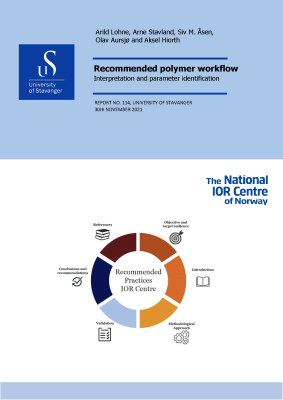Recommended polymer workflow: Interpretation and parameter identification
Keywords:
The National IOR Centre of Norway, polymer workflows, polymer floodingSynopsis
Injecting a polymer solution into a porous medium significantly increases the modeling complexity, compared to model a polymer bulk solution. Even if the polymer solution is injected at a constant rate into the porous medium, the polymers experience different flow regimes in each pore and pore throat. The main challenge is to assign a macroscopic porous media “viscosity” to the fluid which can be used in Darcy law to get the correct relationship between the injection rate and pressure drop. One can achieve this by simply tabulating experimental results (e.g., injection rate vs pressure drop). The challenge with the tabulated approach is that it requires a huge experimental database to tabulate all kind of possible situations that might occur in a reservoir (e.g., changing temperature, salinity, flooding history, permeability, porosity, wettability etc.). The approach presented in this report is to model the mechanisms and describe them in terms of mathematical models. The mathematical model contains a limited number of parameters that needs to be determined experimentally. Once these parameters are determined, there is in principle no need to perform additional experiments.
References
https://doi.org/10.3997/2214-4609.201601771
2. Stavland, A., Jonsbråten, H.C., Lohne, A., Moen, A., and Giske, N.H., "Polymer Flooding - Flow Properties in Porous Media Versus Rheological Parameters," SPE 131103-MS presented at SPE EUROPEC/EAGE Annual Conference and Exhibition, Barcelona, Spain, 14-17 June 2010.
https://doi.org/10.2118/131103-MS
3. Jouenne, S. and Levache, B., "Universal viscosifying behavior of acrylamide-based polymers used in enhanced oil recovery," Journal of Rheology, vol. 64 (5), pp. 1295-1313, 2020.
https://doi.org/10.1122/8.0000063
4. Lohne, A., Stavland, A., and Reichenbach-Klinke, R., "Modeling of Associative Polymer Flow in Porous Medium," Tu B 08 presented at IOR 2019 - 20th European Symposium on Improved Oil Recovery, Pau, France, 8-11 April 2019.
https://doi.org/10.3997/2214-4609.201900117
5. Chauveteau, G., "Fundamental Criteria in Polymer Flow Through Porous Media," in Water-Soluble Polymers, Adv. in Chem. Ser., J. E. Glass, Ed., 1986.
https://doi.org/10.1021/ba-1986-0213.ch014
6. Howe, A.M., Clarke, A., and Giernalczyk, D., "Flow of concentrated viscoelastic polymer solutions in porous media: effect of Mw and concentration on elastic turbulence onset in various geometries," Soft Matter, vol. 11 (32), pp. 6419-6431, 2015.
https://doi.org/10.1039/C5SM01042J
7. Lohne, A., Han, L., van der Zwaag, C., van Velzen, H., Mathisen, A.-M., Twynam, A., Hendriks, W., Bulgachev, R., and Hatzignatiou, D.G., "Formation Damage and Well Productivity Simulation," SPE Journal, vol. 15 (3), pp. 751-769, 2010.
https://doi.org/10.2118/122241-PA
8. Dupuis, G., Al-Khoury, P., Nieuwerf, J., and Favero, C., "Using Polymer EOR to Reduce Carbon Intensity While Increasing Oil Recovery," IOR 2021, 2021.
https://doi.org/10.3997/2214-4609.202133048


